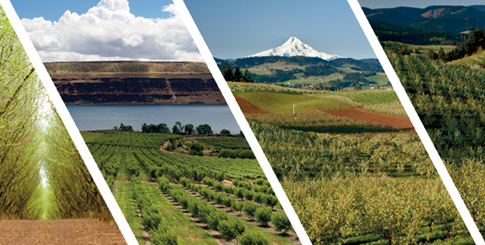Trade Trends: Imports & Exports
Oregon exports nearly $2 billion in annual agricultural products, with fruits and vegetables claiming 25 percent of shipments. Many ship to nearby ports of call in Canada and Mexico, while others go to Asia, the European Union, and the Middle East. Top exports include cherries, blueberries, cranberries, pears, apples, potatoes, and onions.
Points of departure and transportation mode vary by crop. “Oregon ships fresh potatoes and onions to Canada and Mexico, mostly by truck,” notes Botsford. The same is true for root crops, sweet corn, and watermelon to Canada, while Mexico is the largest onion and potato importer. Potatoes and onions also ship via container ship to Korea, Japan, Latin America, Taiwan, and Philippines.
Fresh apple and pear exports move primarily by sea. Pacific Rim countries, India, and Latin America are the top destinations for Oregon-grown apples. Mexico is rebounding as an apple export destination, after changes in import duties (though ongoing trade negotiations could have an impact). Mexico is also Oregon’s biggest pear export destination, served by truck. Pears also ship by sea to Brazil, China, Latin America, Taiwan, and the United Arab Emirates.
New Asia markets and additional freight flights from Portland continue to spur exports. Japan, South Korea, and China are important markets for Oregon cherries and blueberries, with growth in fresh blackberries as well. Other Pacific Rim countries like Vietnam, as well as Middle East markets also receive cherries and berries from the Pacific Northwest.
Challenges: Old & New
Oregon’s fresh deal faces the same challenges as anywhere—weather, labor, and transportation—with some regional distinctions. Managing temperature and rainfall variations can be difficult for Willamette Valley growers. “A really wet spring made for a late start in 2017,” recalls Neubeck. “And last summer we had some really hot spells; nothing catastrophic, just slight disruptions.”
Some crops, however, benefited from the high heat. “It was good for watermelons at harvest; the crop was large,” recalls Botsford. The 2017 potato crop was also stellar. “It’s one of the best potato crops we’ve ever had, volume-wise, and we have a very good potato market,” he adds.
Winter snows and freezes can damage tree fruit and berry crops, and industry infrastructure. In Eastern Oregon, onion shippers are still recovering from building collapses after huge snowfalls in early 2017.
Storage sheds were widely affected and a lack of construction labor delayed rebuilding. Some viewed the rebuilding as an opportunity for expansion: Baker & Murakami installed a new packing line this season and Kitamura says, “All of our capacity is up.”



